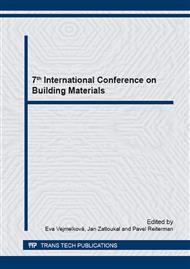[1]
M. Šeflová, M. Volf and T. Pavlů, Thermal Properties of Concrete with Recycled Aggregate, Advanced Materials Research 1054 (2014) 227-233.
DOI: 10.4028/www.scientific.net/amr.1054.227
Google Scholar
[2]
T. - Ch. Ling, Ch. - S. Poon a S. -C. Kou, Influence of recycled glass content and curing conditions on the properties of self-compacting concrete after exposure to elevated temperatures, Cement and Concrete Composites 34(2) (2012) 265-272.
DOI: 10.1016/j.cemconcomp.2011.08.010
Google Scholar
[3]
P. Reiterman, O. Holčapek, K. Polozhiy, P. Konvalinka, Fracture Properties of Cement Pastes Modified by Fine Ground Ceramic Powder, Advanced Materials Research 1054 (2014) 182-187.
DOI: 10.4028/www.scientific.net/amr.1054.182
Google Scholar
[4]
M. Čáchová, D. Koňáková, E. Vejmelková, K. Polozhiy, R. Černý, Pore Distribution and Water Vapor Diffusion Parameters of Lime Plasters with Waste Brick Powder, Advanced Materials Research 1054 (2014) 205-208.
DOI: 10.4028/www.scientific.net/amr.1054.205
Google Scholar
[5]
M. Čáchová, D. Koňákoá, E. Vejmelková, M. Keppert, P. Reiterman, A. Krojidlová, R. Černý. Mechanical and Thermal Properties of Composites Containing Waste Coir Pith, Advanced Materials Research 1054 (2014) 238-242.
DOI: 10.4028/www.scientific.net/amr.1054.238
Google Scholar
[6]
O. Holčapek, P. Reiterman, P. Konvalinka, High Temperature Composite of Aluminous Cement with Addition of Metakaolin and Ground Bricks Dust. Applied Mechanics and Materials 486 (2013) 406-411.
DOI: 10.4028/www.scientific.net/amm.486.406
Google Scholar
[7]
J. Silva, J. de Brito, R. Veiga, Incorporation of fine ceramics in mortars, Construction and Building Materials 23(1) (2009) 556-564.
DOI: 10.1016/j.conbuildmat.2007.10.014
Google Scholar
[8]
Z. Ge, Z. Gao, R. Sun, L. Zheng, Mix design of concrete with recycled clay-brick-powder using the orthogonal design method, Construction and Building Materials 31 (2012) 289-293.
DOI: 10.1016/j.conbuildmat.2012.01.002
Google Scholar
[9]
ČSN EN 12390-3 Testing of hardened concrete – Part 3: Compressive strength. Czech Standardization Institute, Prague, (2002).
Google Scholar
[10]
E. Vejmelková, M. Pavlíková, Z. Keršner, P. Rovnaníková, M. Ondráček, M. Sendlmajer, R. Černý, High performance concrete containing lower slag amount: A complex view of mechanical and durability properties. Construction and Building Materials 23(6) (2009).
DOI: 10.1016/j.conbuildmat.2008.11.018
Google Scholar
[11]
O. Holčapek, P. Reiterman, P. Konvalinka, Fracture characteristics of refractory composites containing metakaolin and ceramic fibers, Advances in Mechanical Engineering: article in press, DOI: 10. 1177/1687814015573619.
DOI: 10.1177/1687814015573619
Google Scholar


